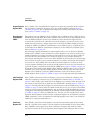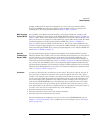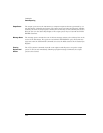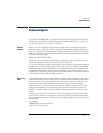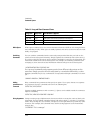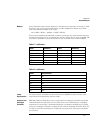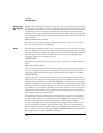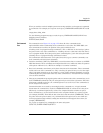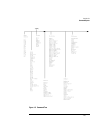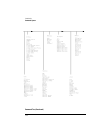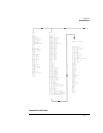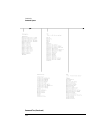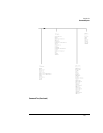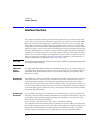
1-27
Introduction
Command Syntax
When you read the result of multiple queries into string variables, each response is separated
by a semicolon. For example, the response of the query :TIMEBASE:RANGE?;DELAY? would
be:
<range_value>;<delay_value>
Use the following program message to read the query :TIMEBASE:RANGE?;DELAY? into
multiple numeric variables:
ENTER 707;Result1,Result2
The Command
Tree
The command tree in Figure 1-5 on page 1-29 shows all of the commands in the
Agilent 86100A and the relationship of the commands to each other. The IEEE 488.2 com-
mon commands do not affect the position of the parser within the tree.
A leading colon or a program message terminator (<NL> or EOI true on the last byte) places
the parser at the root of the command tree. A leading colon is a colon that is the first charac-
ter of a program header. Executing a subsystem command places you in that subsystem until
a leading colon or a program message terminator is found.
The commands in this instrument can be placed into three types: common commands, root
level commands, and subsystem commands.
• Common commands (defined by IEEE 488.2) control functions that are common to all IEEE
488.2 instruments. These commands are independent of the tree and do not affect the position
of the parser within the tree. *RST is an example of a common command.
• Root level commands control many of the basic functions of the instrument. These commands
reside at the root of the command tree. They can always be parsed if they occur at the begin-
ning of a program message or are preceded by a colon. Unlike common commands, root level
commands place the parser back at the root of the command tree. AUTOSCALE is an example
of a root level command.
• Subsystem commands are grouped together under a common node of the command tree, such
as the TIMEBASE commands. Only one subsystem may be selected at a given time. When the
instrument is initially turned on, the command parser is set to the root of the command tree
and no subsystem is selected.
Command headers are created by traversing down the command tree. A legal command
header from the command tree would be :TIMEBASE:RANGE. It consists of the subsystem
followed by a command separated by colons. The compound header contains no spaces.
In the command tree, use the last mnemonic in the compound header as a reference point
(for example, RANGE). Then find the last colon above that mnemonic (TIMEBASE:). That is
the point where the parser resides. Any command below this point can be sent within the
current program message without sending the mnemonics which appear above them (for
example, REFERENCE).
Use a colon to separate two commands in the same subsystem.
OUTPUT 707;":CHANNEL1:RANGE 0.5;OFFSET 0"




